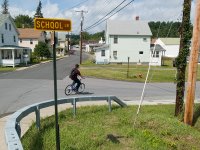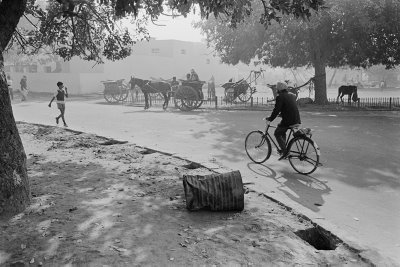Back in 1969 I was lucky enough to have a state of the art 35mm camera. The shutter was instantly responsive. The view through the finder let me see what was happening around, as well as in, the frame. This made it relatively easy to “choreograph” a picture of uncontrolled moving subjects. You had to wind the film with a lever after each picture, so usually you got only one try at action shots. This was great for your concentration.
 Most recent cameras, film and digital, allow rapid sequence shooting. I think this may be a bug disguised as a feature. Even if you don’t set the camera to continuous shooting, and I never do, you know that you can hit the release again and get another exposure a fraction of a second after the first. I’ve been looking at these two pictures, made a couple weeks ago, and I can’t quite decide which works better.
Most recent cameras, film and digital, allow rapid sequence shooting. I think this may be a bug disguised as a feature. Even if you don’t set the camera to continuous shooting, and I never do, you know that you can hit the release again and get another exposure a fraction of a second after the first. I’ve been looking at these two pictures, made a couple weeks ago, and I can’t quite decide which works better. The first has more immediate impact, but the second has more complexity in the relationships. I keep wondering if, with only one chance, I might have done something a little better than either one.
The first has more immediate impact, but the second has more complexity in the relationships. I keep wondering if, with only one chance, I might have done something a little better than either one.School Lane, Ausable Forks, New York, 2006

2 comments:
Hi Carl:
Indeed an attention-grabbing images from two worlds apart in time and in space: one shows no sign of a modern world but one can feel and see the light that cast the shadows life and people living assemble, and the other two, shows in vivid colours: signs of a modern and boring mechanized urban planning and a sanitized living environment and the solitude of modern life.
Alejandro
Thank you, Michael.
The picture is an old favorite. As for seeing it before, it's never been published in a high profile venue, but a lot of my work from this period was popular (through a stock agency) with textbook publishers. Sociology, anthropology, and comparative religion texts bought this and others and I kept getting tiny little checks as they kept them in new editions. So it's just barely possible that you encountered the picture a long time ago. If so and it rings a bell, you've got one hell of a good visual memory.
Post a Comment